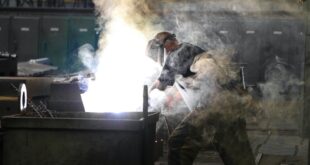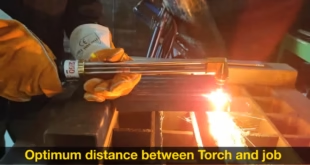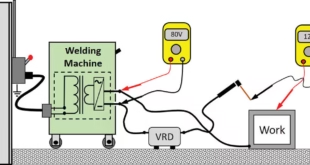Welding Accidents And Their Causes
Introduction
Welding is an essential process used across various industries, including construction, manufacturing, and automotive sectors. It involves joining metals together by applying heat and creating a strong bond. While welding is a crucial skill, it also carries inherent risks and hazards that need to be understood and managed effectively.
The importance of understanding welding accidents cannot be overstated. It is vital for the safety and well-being of welders, as well as the overall workplace environment. By being aware of the potential risks and causes of accidents, workers can take appropriate precautions to prevent injuries and maintain a secure working environment.
This introduction will delve into the significance of understanding welding accidents and provide an overview of the most common types of accidents that can occur during welding operations. By familiarizing ourselves with these accidents, we can better comprehend the precautions and safety measures required to mitigate the associated risks.
Whether you are a welder, employer, or someone interested in welding safety, gaining knowledge about welding accidents and their causes is essential for promoting a culture of safety, reducing accidents, and ensuring the well-being of individuals involved in welding activities.
Electric shock accidents
Causes of Electric Shock Accidents:
- Improper grounding of welding equipment: If the welding equipment is not adequately grounded, it can create a risk of electric shock. When welding, it is crucial to ensure that the equipment is properly grounded to provide a safe path for electrical currents.
- Inadequate insulation of welding cables: Insulation plays a vital role in preventing electric shock. If the insulation on welding cables is damaged or inadequate, it can expose the welder to the risk of electric shock by allowing the electrical current to come into contact with unintended surfaces or the welder themselves.
- Working in wet or damp conditions: Water is a conductor of electricity, and working in wet or damp conditions increases the risk of electric shock. Moisture can compromise the insulation of cables or create a path for electrical current to flow through unintended routes, posing a significant danger to welders.
Prevention of Electric Shock Accidents:
- Ensure proper grounding of equipment: Before starting any welding operation, verify that the welding equipment is correctly grounded. This involves connecting the welding machine to a ground point or earth ground. Proper grounding helps to redirect electrical currents safely, reducing the risk of electric shock.
- Regularly inspect cables for damage: Perform routine inspections of welding cables to identify any signs of wear, fraying, or damage to the insulation. If any issues are detected, the cables should be promptly repaired or replaced to maintain their integrity and prevent electric shock hazards.
- Use appropriate personal protective equipment (PPE): Personal protective equipment is crucial in preventing electric shock accidents. When welding, always wear insulated gloves, boots, and other appropriate PPE to provide an additional layer of protection against electrical currents. These items should be in good condition and properly maintained.

Fire and Explosion Accidents
Causes of Fire and Explosion Accidents:
1. Ignition of flammable materials in the work area: Welding produces sparks, hot metal fragments, and heat that can ignite nearby flammable materials such as oil, paint, solvents, or gases. If these materials are not properly managed or removed from the work area, they can lead to fires or explosions.
2. Lack of fire-resistant barriers or screens: Without appropriate fire-resistant barriers or screens, sparks and molten metal can escape the welding area, potentially igniting nearby flammable materials or causing burns to nearby individuals.
3. Welding near containers with flammable substances: Welding in close proximity to containers, tanks, or pipes containing flammable substances increases the risk of fire or explosion accidents. Heat generated during welding can cause the contents to ignite or explode, leading to severe consequences.
Prevention of Fire and Explosion Accidents:
- Clear work area of flammable materials: Before starting any welding work, ensure that the immediate work area is free from flammable materials. Remove or properly store any combustible substances, liquids, or debris that could be ignited by sparks or heat generated during welding.
- Use fire-resistant blankets or screens: Set up fire-resistant blankets or screens around the welding area to contain sparks, splatter, and hot metal fragments. These barriers provide an extra layer of protection, preventing them from reaching flammable materials or individuals nearby.
- Have fire extinguishers readily available: Keep fire extinguishers with the appropriate rating and type near the welding area. Train workers on how to use fire extinguishers effectively and ensure that they are regularly inspected and maintained. Prompt access to fire extinguishers can help control small fires before they escalate.
Eye Injuries
Causes of Eye Injuries:
1. Insufficient eye protection: Welding produces intense light, sparks, and UV radiation that can cause serious damage to the eyes. Failing to use adequate eye protection leaves welders vulnerable to eye injuries, including burns, retinal damage, and cataracts.
2. Exposure to intense light and UV radiation: The intense arc light and UV radiation emitted during welding can cause temporary or permanent damage to the eyes. Prolonged exposure without proper protection can result in conditions such as arc eye (welder’s flash) or long-term vision problems.
Prevention of Eye Injuries:
- Use welding helmets with appropriate shading lenses: Welders should always wear a welding helmet that has the correct shading lens for the specific welding process being performed. The lens shade number should correspond to the intensity of the light produced by the welding process. This shields the eyes from harmful radiation and intense light.
- Wear safety glasses with side shields: In addition to a welding helmet, it is important to wear safety glasses with side shields underneath for further eye protection. Safety glasses provide a barrier against flying debris, sparks, and particles that can cause eye injuries.
- Implement regular eye safety practices: Promote a culture of eye safety by incorporating the following practices:
– Conduct regular eye examinations to identify and address any pre-existing eye conditions.
– Encourage frequent breaks during prolonged welding tasks to rest the eyes.
– Keep the work area clean and clear of debris that could become projectiles during welding.
– Train welders on proper eye protection usage, maintenance, and cleaning techniques.
– Promptly address any eye injuries or symptoms, and seek medical attention when necessary.
Burns and Thermal Injuries
Causes of Burns and Thermal Injuries:
1. Inadequate protective clothing and equipment: Insufficient or improper use of protective clothing and equipment can leave welders susceptible to burns and thermal injuries. Exposed skin and inappropriate clothing materials increase the risk of direct contact with hot surfaces, sparks, or molten metal.
2. Proximity to sparks and molten metal: Welding produces sparks, splatter, and molten metal that can cause burns upon contact with the skin. Working in close proximity to these hazards without proper protection increases the likelihood of burn injuries.
Prevention of Burns and Thermal Injuries:
- Wear flame-resistant clothing and gloves: Always wear flame-resistant clothing, such as coveralls or welding jackets, to provide a barrier between the skin and hot surfaces or sparks. Choose gloves specifically designed for welding that offer heat resistance and dexterity, protecting the hands from burns and thermal hazards.
- Use welding curtains or screens: Set up welding curtains or screens around the welding area to prevent sparks, splatter, or molten metal from reaching nearby individuals. These barriers serve as protection against burns and thermal injuries caused by contact with hazardous materials.
- Keep a first aid kit nearby: Accidents can happen despite precautions, so it is important to have a well-stocked first aid kit readily available near the welding area. Promptly treating burns and thermal injuries can minimize their severity and provide immediate relief to the affected individual.
Inhalation of Toxic Fumes and Gases
Causes of Inhalation of Toxic Fumes and Gases:
1. Lack of ventilation or exhaust systems: Inadequate ventilation in the welding area can lead to the accumulation of toxic fumes and gases. Without proper airflow, the concentration of hazardous substances increases, putting welders at risk of inhaling harmful airborne contaminants.
2. Failure to use proper respiratory protection: Welding generates a variety of toxic fumes, gases, and particulates that can cause respiratory problems if inhaled. Neglecting to use appropriate respiratory protection, such as respirators or masks, exposes welders to the harmful effects of these substances.
Prevention of Inhalation of Toxic Fumes and Gases:
- Work in well-ventilated areas or use local exhaust systems: Welding should be performed in areas with adequate ventilation to facilitate the removal of toxic fumes and gases. If working indoors, ensure that there is sufficient airflow or use local exhaust systems, such as fume extraction hoods, to capture and remove airborne contaminants at the source.
- Wear appropriate respirators: Depending on the type of welding being performed and the associated hazards, select and wear the appropriate respirator or mask. Respirators should be specifically designed for welding applications and capable of filtering out the specific fumes and gases generated. Regularly inspect and maintain respirators to ensure their effectiveness.
- Be aware of material hazards and use proper ventilation techniques: Different welding materials, coatings, or surface treatments can produce unique hazardous fumes and gases. Understand the potential risks associated with the materials being welded and apply appropriate ventilation techniques, such as using local exhaust ventilation or positioning fans to direct fumes away from the welder’s breathing zone.
Noise-Induced Hearing Loss
Causes of Noise-Induced Hearing Loss:
Exposure to high noise levels without protection: Welding processes often produce high levels of noise that can lead to long-term hearing damage. Prolonged exposure to these loud noise levels without adequate hearing protection can result in noise-induced hearing loss (NIHL).
Prevention of Noise-Induced Hearing Loss:
- Use hearing protection devices: Wear appropriate hearing protection devices, such as earplugs or earmuffs, while engaging in welding activities. These devices help to reduce the intensity of noise reaching the ears, protecting against noise-induced hearing loss. Ensure that the hearing protection is correctly fitted and worn consistently during welding operations.
- Limit exposure time to high noise levels: Limit the duration of exposure to high noise levels by implementing measures such as job rotation or scheduling breaks in quieter areas. Minimizing the cumulative exposure time to excessive noise can significantly reduce the risk of developing noise-induced hearing loss.
Musculoskeletal Injuries
Causes of Musculoskeletal Injuries:
Improper body positioning and repetitive movements: Welding tasks often require prolonged periods of working in awkward positions or performing repetitive movements, which can strain the muscles, tendons, and joints. These repetitive motions and poor body positioning can lead to musculoskeletal injuries, including strains, sprains, and overuse injuries.
Prevention of Musculoskeletal Injuries:
- Maintain proper ergonomics: Practice good ergonomics while welding by ensuring that workstations are set up in a way that promotes comfortable and efficient body positioning. Adjust work surfaces, tables, and welding equipment to appropriate heights and angles to minimize strain on the body. Use supportive seating and ergonomic tools when available.
- Take regular breaks and perform stretching exercises: Incorporate regular breaks during welding tasks to allow the body to rest and recover. During these breaks, perform stretching exercises to alleviate muscle tension and improve flexibility. Focus on stretching the neck, shoulders, back, and limbs to target areas commonly affected by welding-related strain.
Electric Arc Flash Accidents
Causes of Electric Arc Flash Accidents:
1. Lack of equipment maintenance and inspection: Failure to properly maintain and inspect electrical equipment increases the risk of electric arc flash accidents. Over time, equipment can develop faults or wear out, which can lead to electrical malfunctions and the potential for arc flashes.
2. Inadequate personal protective equipment: Insufficient or improper use of personal protective equipment (PPE) can leave workers vulnerable to the dangers of electric arc flashes. This includes wearing inadequate or non-flame-resistant clothing, as well as not using appropriate face shields or protective eyewear.
Prevention of Electric Arc Flash Accidents:
- Regularly maintain and inspect electrical equipment: Establish a robust maintenance program for electrical equipment, including routine inspections, testing, and repairs. This helps identify and address potential issues before they escalate into arc flash hazards. Adhere to manufacturer’s guidelines and industry standards for maintenance procedures.
- Use appropriate flame-resistant clothing and face shields: Wear flame-resistant clothing that complies with relevant safety standards to protect against electric arc flashes. This includes flame-resistant shirts, pants, coveralls, and jackets. Additionally, use face shields or arc-rated protective shields to safeguard the face and eyes from the intense heat and light generated by arc flashes.
FAQs
What are the most common welding accidents?
The most common welding accidents include electric shocks, fires and explosions, eye injuries, burns and thermal injuries, inhalation of toxic fumes and gases, noise-induced hearing loss, musculoskeletal injuries, and electric arc flash incidents.
What accidents can happen in welding?
Accidents that can happen in welding include electric shocks, fires and explosions, eye injuries, burns and thermal injuries, inhalation of toxic fumes and gases, noise-induced hearing loss, musculoskeletal injuries, and electric arc flash incidents.
What are the 5 hazards of welding?
The 5 hazards of welding include electric shock, fire and explosion, inhalation of toxic fumes and gases, noise-induced hearing loss, and musculoskeletal injuries.
What is the most common hazard in welding?
The most common hazard in welding is the risk of electric shock.
What are 10 most common welding defects?
The 10 most common welding defects include lack of fusion, incomplete penetration, undercutting, porosity, cracking, excessive spatter, distortion, tungsten inclusion (in TIG welding), slag inclusion, and improper weld size.
How can we prevent welding accidents?
Welding accidents can be prevented by ensuring proper training, using personal protective equipment (PPE), maintaining equipment and ventilation, adhering to safety guidelines and regulations, and implementing hazard mitigation strategies.
What is PPE in welding?
PPE stands for Personal Protective Equipment in welding. It includes items such as welding helmets, safety glasses, face shields, gloves, aprons, and protective clothing designed to protect welders from hazards such as sparks, radiation, heat, and molten metal.
What are the 7 hazards of welding?
The 7 hazards of welding include electric shock, fire and explosion, eye injuries, burns and thermal injuries, inhalation of toxic fumes and gases, noise-induced hearing loss, and musculoskeletal injuries.
Why is PPE important in welding?
PPE is important in welding as it provides protection against various hazards, such as sparks, radiation, heat, and molten metal. It helps prevent injuries to the eyes, face, hands, and body, ensuring the safety and well-being of welders.
What are the risk hazards for welding?
The risk hazards for welding include electric shock, fire and explosion, exposure to toxic fumes and gases, eye injuries, burns and thermal injuries, noise-induced hearing loss, and musculoskeletal injuries.
What is an accident welding?
An accident in welding refers to an unintended and undesirable event that causes harm, injury, or damage during welding operations. This can include incidents such as electric shocks, fires, injuries, or other unexpected events.
What are fire hazards when welding?
Fire hazards when welding include sparks and hot slag igniting flammable materials, inadequate fire-resistant barriers or screens, welding near containers with flammable substances, and insufficient fire safety measures. These can lead to fires or explosions if proper precautions are not taken.
Conclusion
In conclusion, understanding and addressing welding accidents is of utmost importance to ensure the safety and well-being of welders. By examining the common welding accidents and their causes, we have highlighted the need for proper training and implementation of safety measures in welding operations.
Accidents such as electric shocks, fires and explosions, eye injuries, burns and thermal injuries, inhalation of toxic fumes and gases, noise-induced hearing loss, musculoskeletal injuries, and electric arc flash incidents can have severe consequences. However, through preventive measures, many of these accidents can be avoided.
Proper training and education on welding safety practices, including the use of personal protective equipment (PPE), the importance of ventilation, maintaining equipment, and adhering to safety guidelines, are crucial. Welders should be trained to recognize potential hazards, understand the risks associated with their work, and take appropriate measures to mitigate them.
It is essential to emphasize the significance of adherence to safety guidelines and regulations. Following industry standards and local regulations ensures a standardized approach to safety and helps protect workers from avoidable accidents. Employers must provide a safe working environment, including adequate ventilation, appropriate safety equipment, and regular equipment maintenance.
By prioritizing proper training, safety measures, and adherence to guidelines and regulations, welding accidents can be significantly reduced, creating a safer work environment for welders. Let us all recognize the value of safety and work together to foster a culture of safety within the welding industry.
 Welding of Welders All about Welding and Welders
Welding of Welders All about Welding and Welders



